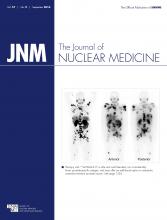The Society of Nuclear Medicine and Molecular Imaging (SNMMI) will periodically define new guidelines or update prior guidelines for nuclear medicine practice, independently or in collaboration with other organizations, to help advance the science of nuclear medicine and to improve the quality of patient care. In the 2016 September issue of the Journal of Nuclear Cardiology, an updated joint American Society of Nuclear Cardiology (ASNC) imaging guideline and SNMMI procedure standard for PET nuclear cardiology is being published addressing the areas of PET myocardial perfusion and metabolism clinical imaging (1). The document, which is the outcome of close collaboration between SNMMI and ASNC and among experts in the field from both organizations, has been subjected to extensive review, requiring the approval of several committees from both organizations and, ultimately, the endorsement of both the SNMMI and the ASNC boards of directors.
To ensure quality health care, the Centers for Medicare and Medicaid Services have recently implemented initiatives toward achieving effective, safe, efficient, patient-centered, equitable, and timely care (2). In comparison with SPECT, PET has superior imaging properties that help meet some of these quality goals, such as the ability to achieve a higher myocardial count density during a shorter acquisition time and with less activity scattered into the myocardial region from the adjacent subdiaphragmatic viscera. PET myocardial perfusion imaging provides high diagnostic accuracy (is effective), has low radiation exposure (is safe), requires short acquisition times (is efficient), and accommodates ill or higher-risk patients, as well as those with a large body habitus (is patient-centered), providing equitable and timely care.
Although SPECT assessment of stress and rest myocardial perfusion has been firmly established as an important diagnostic and prognostic tool for evaluating myocardial ischemia and prior infarction, the interpretation of myocardial perfusion SPECT studies has been primarily qualitative or semiquantitative. The detrimental effects of soft-tissue attenuation, which tends to degrade image quality and increase interpretive errors, have long been recognized with SPECT. PET provides better spatial and temporal resolution than SPECT and allows reliable and accurate soft-tissue attenuation correction, particularly in patients who are obese or have a large body habitus (3). In concert with tracer-kinetic modeling and robust attenuation correction, PET permits the assessment of regional myocardial blood flow (MBF) of the left ventricle in absolute terms (mL/g/min) (4).
MYOCARDIAL PERFUSION
Beyond the quality initiatives of the Centers for Medicare and Medicaid Services, an additional driver for cardiac PET comes from a new health-care trend in cardiovascular medicine that suggests a paradigm shift in the evaluation and management of patients with coronary artery disease (CAD) from an anatomic gold standard (coronary angiography) to a functional one (fractional flow reserve). Quantitative assessment of PET MBF in absolute terms is concurrent with the recent shift in the management of CAD. PET absolute MBF provides a valuable noninvasive alternative to functional assessment of CAD that may obviate coronary angiography. Moreover, noninvasive quantification of MBF extends the scope of conventional myocardial perfusion imaging from detection of end-stage, advanced, and flow-limiting epicardial CAD to balanced reduction of MBF in all 3 vascular territories as well as identification of early stages of atherosclerosis or microvascular dysfunction (5). Adding quantification of hyperemic MBF and flow reserve to the visual interpretation of PET regional perfusion defects has been shown to improve the detection of CAD burden and accurately risk-stratify patients with varying clinical presentations (6–9).
Absolute quantitative MBF may provide further insight into the coronary steal phenomenon, defined as an absolute decrease in vasodilator stress perfusion from resting blood flow in collateral-dependent myocardium as well as in hibernation, in which a low resting MBF may or may not increase with stress but is nonetheless viable, requiring an assessment of myocardial metabolism (1). In the case of hibernation, imaging of myocardial perfusion can be combined with 18F-FDG PET imaging of myocardial metabolism to assess myocardial viability in areas of resting hypoperfusion and dysfunctional myocardium (10).
METABOLISM
In the last few years, PET scanners combined with CT or MR have proliferated. Although the use of such combined scanners is primarily for oncologic applications, coregistration of 18F-FDG metabolic imaging with the morphologic, functional, and tissue imaging attributes of CT and MR presents new opportunities for disease characterization, such as diagnosing active cardiac inflammation in sarcoidosis, hallmarked by inflammatory injury, noncaseating granuloma formation, and organ dysfunction (11,12). Another emerging application of 18F-FDG is the identification of cardiovascular infections, particularly prosthetic valve or device infections (13–18). Use of implantable electronic cardiac devices, including pacemakers, resynchronization therapy devices, and implantable defibrillators; left ventricular assist devices; and prostheses, such as valves and annular ring implants, has become rather common in the contemporary practice of cardiology (16). Depending on the disease process, measurements of 18F-FDG metabolism can reflect the rates of cellular glucose utilization from either cardiac myocytes or proinflammatory cells that infiltrate the myocardium (1). Cardiac-device infection and sarcoidosis carry a high risk of death if not identified early and treated appropriately. In vivo 18F-FDG labeling of metabolically active inflammatory cells at the infection site has the advantage of producing superior tomographic PET images with higher spatial and contrast resolution than the labor-intensive in vitro 111In- or 99mTc-labeled white blood cell images, and at a lower radiation exposure to patients (16).
EPILOGUE
The Society of Nuclear Medicine and Molecular Imaging recognizes that the safe and effective use of diagnostic nuclear medicine imaging requires specific training, skills, and techniques. The updated cardiac PET perfusion and metabolism imaging guidelines are an educational tool designed to assist practitioners in providing appropriate care for patients. It is important to keep in mind, however, that the practice of medicine entails not only the science of imaging but also the art of preventing, diagnosing, alleviating, and treating disease.
DISCLOSURE
No potential conflict of interest relevant to this article was reported.
Footnotes
Published online May 19, 2016.
- © 2016 by the Society of Nuclear Medicine and Molecular Imaging, Inc.
REFERENCES
- Received for publication May 4, 2016.
- Accepted for publication May 6, 2016.







